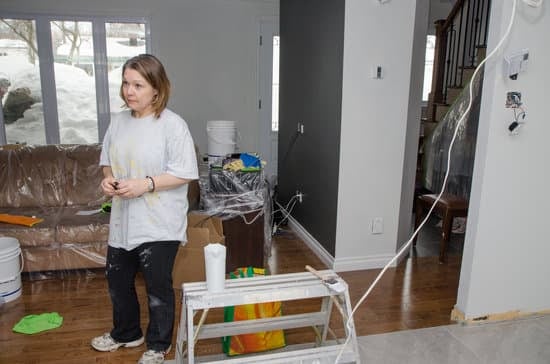Where do I claim home improvements on taxes? If you’re a homeowner looking to make some improvements to your property, you may be eligible for tax deductions.
Understanding these deductions and knowing how to claim them correctly can help you save money when tax season rolls around. In this article, we will guide you through the process of claiming home improvements on your taxes, including what qualifies as an eligible improvement, how to keep track of expenses, and which forms to use when filing.
When it comes to claiming home improvements on taxes, it’s essential to understand the criteria for eligibility. Not all home improvements qualify for tax deductions, so it’s crucial to know which expenses can be claimed and which cannot. By familiarizing yourself with the guidelines set by the IRS, you can ensure that you are making legitimate claims and avoiding any potential penalties or audits.
Keeping track of expenses and receipts is another crucial aspect of claiming home improvements on taxes. You will need to provide accurate documentation of the costs associated with the improvements in order to claim them on your taxes. This includes not only the initial costs of materials and labor but also any additional expenses such as permits or inspections. Maintaining thorough records will make the process smoother when it comes time to file your taxes.
Eligible Home Improvements for Tax Deductions
When it comes to claiming home improvements on taxes, it’s important to understand which renovations and upgrades are actually eligible for tax deductions. The IRS has specific guidelines for what qualifies as a deductible home improvement, so it’s crucial to know what you can and cannot claim.
Qualifying Home Improvements
The IRS considers qualifying home improvements as those that add value to your home, prolong its useful life, or adapt it to new uses. This includes renovations such as adding a new room, remodeling a kitchen or bathroom, installing a new HVAC system, or making energy-efficient upgrades. However, regular maintenance or repairs that are necessary to keep your home in good condition generally do not qualify for tax deductions.
Energy Efficiency Upgrades
One of the most common types of home improvements that can be claimed for tax deductions is energy efficiency upgrades. This includes installing solar panels, energy-efficient windows and doors, insulation, and certain heating and cooling systems. These upgrades not only help reduce your energy bills but also qualify for residential energy credits when filing your taxes.
Documentation and Proof
In order to claim home improvements on your taxes, you will need to keep detailed records of all expenses related to the renovations. This includes receipts for materials and labor costs, as well as any permits or inspection reports. Having thorough documentation will help support your claims in case of an audit by the IRS.
By understanding which home improvements are eligible for tax deductions and keeping meticulous records of expenses and receipts, homeowners can ensure they are maximizing their potential tax benefits. However, it’s always best to consult with a tax professional for personalized advice on how to claim home improvements on taxes based on individual circumstances.
Keeping Track of Expenses and Receipts
When it comes to claiming home improvements on taxes, keeping track of all expenses and receipts is crucial for ensuring that you receive the proper deductions. Whether you hire a professional to make these improvements or do them yourself, having detailed records will make the process much smoother when tax season rolls around.
Documentation Is Key
In order to claim home improvements on your taxes, the IRS requires documentation of all expenses related to the project. This includes receipts for materials and supplies, as well as any labor costs if you hired someone to complete the work. It is important to keep meticulous records and organize them in a way that makes them easy to retrieve come tax time.
Understanding What Is Eligible
Not all home improvements are eligible for tax deductions, so it’s important to understand which projects qualify. For example, energy-efficient upgrades such as solar panels or geothermal heating systems often qualify for residential energy credits. Understanding which home improvements are eligible will ensure that you are not wasting time and effort tracking expenses that won’t provide any tax benefits.
Organizational Tips
To keep track of your expenses and receipts for home improvements, consider creating a dedicated filing system specifically for this purpose. Keep all related documents in one place and consider using digital storage options as well to prevent loss or damage. This will make it easier when it comes time to fill out Form 1040 Schedule A: Itemized Deductions or Form 5695: Residential Energy Credits.
By following these tips and keeping meticulous records of your home improvement expenses, you can confidently claim these deductions on your taxes and potentially save money in the process.
Form 1040 Schedule A
When it comes to claiming home improvements on taxes, Form 1040 Schedule A is the key document to look at. This form allows you to itemize your deductions, including any eligible home improvement expenses. It’s important to note that in order to claim home improvement tax deductions, you must choose to itemize your deductions instead of taking the standard deduction.
On Schedule A, you will need to report your total allowable itemized deductions, which can include eligible home improvement expenses such as mortgage interest, property taxes, and qualifying medical expenses. Under the section for “Interest You Paid,” be sure to include any mortgage interest paid on a loan used to improve your main or secondary residence.
It’s important to keep in mind that not all home improvement expenses are eligible for tax deductions. Only certain upgrades and renovations that contribute to the value or energy efficiency of your home qualify for this benefit. As with any tax-related matters, it’s always best to consult a tax professional if you have questions about where do I claim home improvements on taxes and whether specific expenses qualify for deductions.
| Types of Home Improvements | Tax Deductible Amount |
|---|---|
| Solar panels installation | 30% federal tax credit |
| New roof installation | Not deductible unless related to a medical use as prescribed by a doctor due to specific condition bearing they live under necessary medical expense categories. |
Using Form 5695
Form 5695: Residential Energy Credits is an essential form for homeowners looking to claim tax credits for eligible home improvements. This form allows homeowners to claim residential energy credits for certain energy-efficient home improvements, helping them save money on their taxes while also reducing their carbon footprint. Here’s a step by step guide on how to use Form 5695 to claim residential energy credits on your taxes:
1. Determine Eligible Home Improvements: Before filling out Form 5695, it’s important to understand which home improvements are eligible for residential energy credits. These may include solar panels, geothermal heat pumps, small wind turbines, and certain energy-efficient heating and cooling systems.
2. Gather Documentation and Receipts: Keep all relevant documentation and receipts for the home improvements you’ve made. This includes invoices, contracts, and manufacturer certifications that demonstrate the eligibility of the products or systems installed.
3. Fill Out Form 5695: Once you have gathered all necessary documentation, fill out Form 5695 to claim residential energy credits for your eligible home improvements. Be sure to accurately report the expenses and details of each improvement in the appropriate sections of the form.
By following these steps and using Form 5695: Residential Energy Credits correctly, homeowners can take advantage of tax credits for their energy-efficient home improvements, ultimately saving money and contributing to a more sustainable environment. If you’re unsure about how to complete this form or have questions about your specific situation, it’s always best to consult a tax professional for personalized advice.
How to Claim Home Improvements on Taxes
When it comes to claiming home improvements on your taxes, it’s important to follow the proper steps to ensure that you maximize your potential deductions. Here’s a step by step guide to help you navigate the process:
1. Determine Eligibility: Before you can claim any home improvements on your taxes, you need to understand which expenses are eligible for deductions. This may include energy-efficient upgrades, medical modifications, or renovations for accessibility purposes.
2. Keep Detailed Records: It’s essential to keep track of all expenses and receipts related to your home improvements. This includes materials, labor costs, and any permits or fees associated with the project.
3. Complete Form 1040 Schedule A: If you choose to itemize your deductions rather than taking the standard deduction, you will need to use Form 1040 Schedule A. This form allows you to report any eligible home improvement expenses for potential tax savings.
4. Utilize Form 5695: For those who have made residential energy improvements, such as installing solar panels or wind turbines, Form 5695 can be used to claim residential energy credits on your taxes.
By following these steps and staying organized with your documentation, you can confidently claim home improvements on your taxes and potentially lower your overall tax liability. If you’re unsure about the eligibility of certain expenses or how to properly complete the necessary forms, consulting a tax professional is always a wise choice. With careful attention to detail and proper guidance, you can make the most of available tax deductions for your home improvement projects.
If you’re still wondering “where do I claim home improvements on taxes,” these steps should guide you in the right direction towards maximizing potential deductions from qualifying home improvement expenses. Whether renovating for energy efficiency or making modifications for medical necessity, understanding and correctly reporting these expenses could lead to significant tax savings come filing season.
Consult a Tax Professional
Consulting a tax professional can be incredibly beneficial when it comes to claiming home improvements on your taxes. A tax professional can provide expert advice and guidance on the specific deductions and credits available for home improvements, ensuring that you take full advantage of any potential tax savings. They can also help you navigate the complex rules and regulations surrounding home improvement tax claims, helping you avoid costly mistakes and potential audits.
When seeking out a tax professional for assistance with home improvement tax claims, it’s important to look for someone with experience in this area. Not all accountants or tax preparers may have the necessary expertise to effectively handle home improvement deductions and credits, so be sure to inquire about their qualifications and experience before enlisting their services. Additionally, consider asking for references or recommendations from other homeowners who have successfully claimed home improvements on their taxes.
In addition to providing valuable guidance on claiming home improvements on your taxes, a tax professional can also help you strategize for future home improvement projects in order to maximize your potential tax benefits. By working with a knowledgeable professional, you can gain peace of mind knowing that your taxes are being handled with accuracy and thoroughness, ultimately saving you time and stress come tax season.
| Benefit of Consulting a Tax Professional | Expertise in Navigating Complex Rules and Regulations for Home Improvement Tax Claims |
|---|---|
| Qualifications | Ensure the tax professional has experience in handling home improvement deductions and credits |
| Recommendations | Consider asking for references or recommendations from other homeowners |
Common Mistakes to Avoid When Claiming Home Improvements on Taxes
When claiming home improvements on taxes, it’s important to be aware of common mistakes that could potentially cost you a tax deduction or even result in penalties. One common mistake to avoid is failing to keep track of expenses and receipts.
It’s crucial to maintain detailed records of all the costs associated with home improvements, including materials, labor, and any other related expenses. Without proper documentation, you may not be able to claim the full amount of your eligible deductions.
Another mistake to steer clear of is inaccurately categorizing home improvements as regular maintenance or repairs. While routine maintenance and minor repairs are generally not eligible for tax deductions, certain home improvements that increase your home’s value, energy efficiency, or accessibility may qualify for tax benefits. Be sure to understand the distinction between these categories and only claim deductions for eligible home improvements.
Additionally, overlooking the eligibility criteria for specific home improvement tax deductions can lead to errors in claiming them on your taxes. For example, when using Form 5695 for residential energy credits, make sure that the improvements meet the requirements set by the IRS in order to qualify for this particular tax credit. Failing to adhere to these guidelines could result in an inaccurate claim and potential consequences from the IRS.
By being mindful of these common mistakes and taking proactive steps to accurately claim your home improvement tax deductions, you can maximize your potential savings while avoiding unnecessary complications with the IRS. If you have any uncertainties or complexities regarding your tax situation and claiming home improvements on taxes, consulting a qualified tax professional is highly recommended. Their expertise can provide valuable guidance and ensure that you navigate the process correctly.
Resources and Additional Information for Home Improvement Tax Claims
In conclusion, understanding where to claim home improvements on taxes can help homeowners take advantage of potential tax deductions. By keeping track of eligible home improvement expenses and receipts, homeowners can use Form 1040 Schedule A for itemized deductions and Form 5695 for residential energy credits. It’s important to consult a tax professional for advice and tips on correctly claiming home improvements on taxes.
When it comes to claiming home improvements on taxes, one common mistake to avoid is not fully understanding the eligibility of certain expenses. That’s why it’s crucial to seek additional information from reliable resources to ensure that you are properly claiming all eligible deductions. Homeowners should also be mindful of the specific requirements and limitations when claiming residential energy credits in order to maximize their tax savings.
Ultimately, by utilizing the information provided in this article and seeking guidance from a tax professional, homeowners can navigate the process of claiming home improvements on taxes with confidence. Taking advantage of these tax deductions can lead to valuable savings and provide financial benefits for individuals who have invested in improving their homes.
Frequently Asked Questions
Can I Deduct Home Improvements on My Tax Return?
You generally cannot deduct home improvements on your tax return. However, certain home improvements that are considered medical expenses or home office expenses may be deductible under specific circumstances.
How Do You Write Off Capital Improvements?
To write off capital improvements, you need to add the cost of the improvement to the basis of your property. This can reduce the capital gains tax you may need to pay when you sell the property.
Is Homeowners Insurance Tax Deductible?
Homeowners insurance is usually not tax deductible for personal primary residences. However, if part of your home is used for business or rental purposes, a portion of the homeowners insurance may be deductible as a business expense.

I’m thrilled to have you here as a part of the Remodeling Top community. This is where my journey as an architect and remodeling enthusiast intersects with your passion for transforming houses into dream homes.





